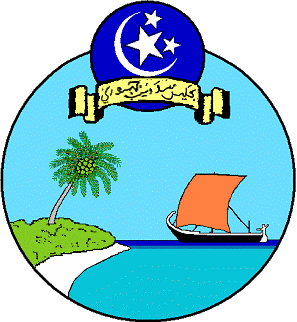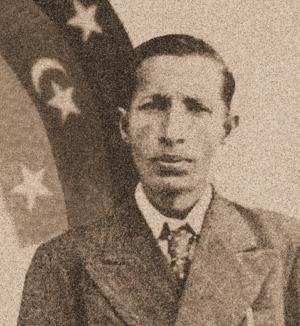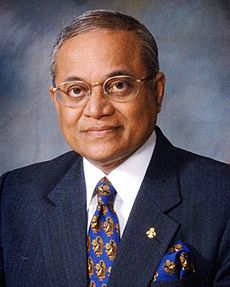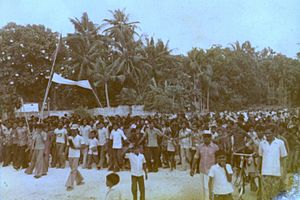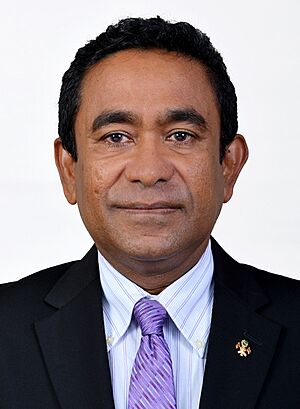President of the Maldives facts for kids
Quick facts for kids President of the Maldives |
|
|---|---|

Presidential flag
|
|
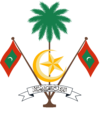
Presidential seal
|
|
| Executive branch of the Maldivian Government | |
| Style | |
| Member of | Cabinet |
| Residence | Muliaage |
| Seat | The President's Office |
| Appointer | Popular vote |
| Term length | 5 years, renewable once |
| Constituting instrument | Constitution of the Maldives |
| Formation |
|
| First holder | Mohamed Amin Didi |
| Deputy | Vice President |
| Salary | MVR 120,000/US$7,818 monthly ($93,816 yearly) |
The president of the Republic of Maldives (Dhivehi: ދިވެހިރާއްޖޭގެ ރައީސުލްޖުމްހޫރިއްޔާ, romanized: dhivehiraajjeyge raeeshuljumhooriyyaa) is the head of state and head of government of the Republic of Maldives and the commander-in-chief of the Maldives National Defence Force.
The current president is Mohamed Muizzu, who was elected in 2023 with a majority of 54.05%, defeating then-president Ibrahim Mohamed Solih.
Constitution
The constitution sets out the rights and duties of the citizens of Maldives and defines the structure of the government of the Maldives. The current constitution was ratified by President Maumoon Abdul Gayyoom on 7 August 2008, and came into effect immediately, replacing and repealing the Constitution of 1998. The current constitution is known by its short title, "Constitution of the Maldives, 2008".
History
Sultanate and First Republic
The first written constitution of the Maldives was brought to effect in 1932 by Sultan Muhammad Shamsuddeen III. This constitution was written on the advice on the then acting governor of Ceylon, Bernard H. Bourdill in 1930.
Soon afterwards in 1934, a second constitution was written and brought into effect.
Under the rule of Sultan Hassan Nooraddeen II, a third constitution was written and brought into effect. On 30 January 1940, the constitutional system was deemed unnecessary and was abolished; only to be reinitiated in 1942 (5th constitution). After another constitution change in 1951, the Maldives was declared a republic in 1953.
Under the rule of President Mohamed Ameen Didi, a new constitution (7th) was brought into effect. This constitution lasted only 8 months, when the republic was abolished and the country went back to a sultanate, under the rule of Sultan Muhammad Fareed Didi. This change introduced yet another constitution brought to effect on 7 March 1954. This was followed by a 9th constitution in 1964 and another in 1967.
Second Republic
After the second republic was declared, new president Ibrahim Nasir ratified a new constitution on 11 November 1968. This constitution was amended thrice, in 1970, 1972 and 1975 respectively.
Under the rule of President Maumoon Abdul Gayyoom, a 12th constitution was introduced in 1998. The government proclaimed that this change was brought to encourage the people of the country to live in friendship, amity and co-operation, and to encourage good deeds and respect among one another and being just, and to live in equality and fraternity.
In June 2008, an assembly, called the "Special Majlis", completed a new constitution. It was ratified by the president on 7 August 2008. This constitution was written over a period of 4 years, started in 2003 when President Gayyoom promised a new 'modern, multi-party and democratic system' in the country following the 2003 Maldives civil unrest and others that followed.
This new constitution includes a judiciary run by an independent commission, and independent commissions to oversee elections and fight corruption. It also reduces the executive powers vested under the president and strengthens the parliament. Among other changes, it states that "a non-Muslim may not become a citizen of the Maldives" and therefore it removed citizenship from around 3,000 Maldivians (0.85% of the population).
Features
The constitution consists of a preamble, fourteen chapters followed by three schedules. Each chapter and schedule focus on a specific topic. The following is a list of chapters and schedules and the focus of each.
Chapters
- Chapter 1 - State, Sovereignty and Citizens
- Chapter 2 - Fundamental Rights and Freedoms
- Chapter 3 - The People's Majlis
- Chapter 4 - The President
- Chapter 5 - The Cabinet of Ministries
- Chapter 6 - The Judiciary
- Chapter 7 - Independent Commissions and Offices
- Chapter 8 - Decentralized Administration
- Chapter 9 - Security Services
- Chapter 10 - Properties, Liabilities and Legal Actions of the State
- Chapter 11 - State of Emergency
- Chapter 12 - Amendment of the Constitution
- Chapter 13 - Application and Construction of the Constitution
- Chapter 14 - Transitional Matters
Schedules
- Schedule 1 - Oaths of Office
- Schedule 2 - Administrative Divisions
- Schedule 3 - National Flag
Elections
Maldives elects on national level a head of state, the president, and a legislature. The president is elected directly for a five-year term by the people.
The Assembly (Majlis) has 93 members. All members are elected directly for a term of five years from 93 single-member constituencies.
British military presence and Suvadive secession
Beginning in the 1950s, The United Kingdom obtained permission to reestablish its wartime RAF Gan airfield in the southernmost Addu Atoll, employing hundreds of locals. Maldives granted the British a 100-year lease on Gan that required them to pay £2,000 a year, as well as some 440,000 square metres on Hitaddu for radio installations. This served as a staging post for British military flights to the Far East and Australia, replacing RAF Mauripur in Pakistan which had been relinquished in 1956.
In 1957, however, the new prime minister, Ibrahim Nasir, called for a review of the agreement in the interest of shortening the lease and increasing the annual payment, and announced a new tax on boats. But Nasir was challenged in 1959 by a local secessionist movement in the three southernmost atolls that benefited economically from the British presence on Gan. This group cut ties with the Maldives government and formed an independent state, the United Suvadive Republic with Abdullah Afeef as president and Hithadhoo as capital. The short-lived state (1959–63) had a combined population of 20,000 inhabitants scattered over Huvadu, Addu and Fua Mulaku. Afeef pleaded for support and recognition from Britain.
Instead the initial British measure of lukewarm support for the small breakaway nation was withdrawn in 1961, when the British signed a treaty with the Maldive Islands without involving Afeef. Following that treaty the Suvadives had to endure an economic embargo. In 1962, Nasir sent gunboats from Malé with government police on board to eliminate elements opposed to his rule. One year later the Suvadive republic was scrapped and Abdullah Afeef went into exile to the Seychelles, where he died in 1993.
Meanwhile, in 1960 the Maldives had allowed the United Kingdom to continue to use both the Gan and the Hitaddu facilities for a thirty-year period, with the payment of £750,000 over the period of 1960 to 1965 for the purpose of Maldives' economic development.
The base was closed in 1976 as part of the larger British withdrawal of permanently stationed forces 'East of Suez' initiated by the Labour government of Harold Wilson.
Independence
On 26 July 1965, the Maldives gained independence under an agreement signed with the United Kingdom. The independent monarchy of the Maldives declined to join the Commonwealth.
The British government retained the use of the Gan and Hitaddu facilities. In a national referendum in March 1968, Maldivians abolished the sultanate and established a republic, which was declared on 11 November 1968.
In line with the broader British policy of decolonization on 26 July 1965 an agreement was signed on behalf of His Majesty the Sultan by Ibrahim Nasir Rannabandeyri Kilegefan, Prime Minister, and on behalf of Queen Elizabeth II by Sir Michael Walker, British Ambassador designate to the Maldive Islands, which ended the British responsibility for the defence and external affairs of the Maldives. The islands thus achieved full political independence, with the ceremony taking place at the British High Commissioner's Residence in Colombo. After this, the sultanate continued for another three years under Muhammad Fareed Didi, who declared himself King rather than Sultan.
On 15 November 1967, a vote was taken in parliament to decide whether the Maldives should continue as a constitutional monarchy or become a republic. Of the 44 members of parliament, forty voted in favour of a republic. On 15 March 1968, a national referendum was held on the question, and 81.23% of those taking part voted in favour of establishing a republic. The republic was declared on 11 November 1968, thus ending the 853-year-old monarchy, which was replaced by a republic under the presidency of Ibrahim Nasir, the former prime minister. As the King had held little real power, this was seen as a cosmetic change and required few alterations in the structures of government.
Nasir presidency
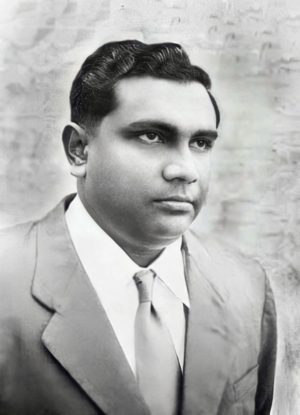
The Second Republic was proclaimed in November 1968 under the presidency of Ibrahim Nasir, who had increasingly dominated the political scene. Under the new constitution, Nasir was elected indirectly to a four-year presidential term by the Majlis (legislature) and his candidacy later ratified by referendum. He appointed Ahmed Zaki as the new prime minister.
In 1973, Nasir was elected to a second term under the constitution as amended in 1972, which extended the presidential term to five years and which also provided for the election of the prime minister by the Majlis. In March 1975, newly elected prime minister Zaki was arrested in a bloodless coup and was banished to a remote atoll. Observers suggested that Zaki was becoming too popular and hence posed a threat to the Nasir faction.
During the 1970s, the economic situation in the Maldives suffered a setback when the Sri Lankan market for Maldives' main export of dried fish collapsed. Adding to the problems was the British decision in 1975 to close its airfield on Gan. A steep commercial decline followed the evacuation of Gan in March 1976. As a result, the popularity of Nasir's government suffered. Maldives' 20-year period of authoritarian rule under Nasir abruptly ended in 1978 when he fled to Singapore. A subsequent investigation claimed that he had absconded with millions of dollars from the state treasury. However, there has been no evidence so far and as a result it was believed that this was a propaganda act of the new government to get popularity and support among the citizens.
Nasir was widely credited with modernising the long-isolated and nearly unknown Maldives and opening them up to the rest of the world, including by building the first international airport (Malé International Airport, 1966) and bringing the Maldives to United Nations membership. He laid the foundations of the nation by modernising the fisheries industry with mechanized vessels and starting the tourism industry – the two prime drivers of today's Maldivian economy.
He was credited with many other improvements such as introducing an English-based modern curriculum to government-run schools and granting vote to Maldivian women in 1964. He brought television and radio to the country with formation of Television Maldives and Radio Maldives for broadcasting radio signals nationwide. He abolished Vaaru, a tax on the people living on islands outside Malé.
Tourism in the Maldives began to be developed by the beginning of the 1970s. The first resort in the Maldives was Kurumba Maldives which welcomed the first guests on 3 October 1972. The first accurate census was held in December 1977 and showed 142,832 persons residing in Maldives.
Nasir was criticized for his authoritarian methods against opponents and for his iron-fisted methods in handling an insurrection by the Addu islanders who formed a short-lived breakaway government – United Suvadives Republic – with closer ties to the British.
Nasir's hasty introduction of the Latin alphabet (Malé Latin) in 1976 instead of local Thaana script – reportedly to allow for the use of telex machines in the local administration – was widely criticised. Clarence Maloney, a Maldives-based U.S. anthropologist, lamented the inconsistencies of the "Dhivehi Latin" which ignored all previous linguistic research on the Maldivian language and did not follow the modern Standard Indic transliteration. At the time of the romanization every island's officials were required to use only one script and they became illiterate overnight.
Officials were relieved when the Tāna script was reinstated by President Gayoom shortly after he took power in 1978. However, Malé Latin continues to be widely used.
Maumoon presidency
As Ibrahim Nasir's second term was coming to an end, he decided not to seek re-election and, in June 1978, the Majlis was called upon to nominate a presidential candidate. Nasir received 45 votes (despite his stated intention not to seek re-election), with the remaining 3 votes for Maumoon Abdul Gayoom, a former university lecturer and Maldivian ambassador to the United Nations. Another ballot was called on 16 June. Maumoon received 27 votes, allowing his name to be put forward as the sole candidate. Five months later, he was elected the new President of the Maldives, with 92.96% of the votes (he would be later re-elected five times as the sole candidate). The peaceful election was seen as ushering in a period of political stability and economic development in view of Maumoon's priority to develop the poorer islands. In 1978, Maldives joined the International Monetary Fund and the World Bank. Tourism also gained in importance to the local economy, reaching more than 120,000 visitors in 1985. The local populace appeared to benefit from increased tourism and the corresponding increase in foreign contacts involving various development projects.
There were three attempts by Nasir supporters and business interests to overthrow Maumoon's government during the 1980s – in 1980, 1983 and 1988.
Whereas the 1980 and 1983 coup attempts against Maumoon's presidency were not considered serious, the third coup attempt in November 1988 alarmed the international community, as about 80 armed mercenaries of the PLOTE Tamil militant group landed on Malé before dawn aboard used cargo vessels which had taken almost 2 days to arrive Male' and failed in controlling the capital city. The plan was ill-prepared and by noon the PLOTE militants and the Maldivian allies fled the country realising they had already lost. soon after the militants had left the Indian Military arrived on the request of President Gayyoom, and their gun ships chased the ships that were being used as get away boats by the PLOTE militants. Nineteen people died in the fighting, and several taken hostage also died when the Indian Gunships fired on the Vessel carrying the hostages. Mercenaries, and later also the mastermind of the attempted coup, were tried and sentenced to death, later commuted to life in prison. Some were later pardoned.
Despite coup attempts, Maumoon served three more presidential terms. In the 1983, 1988, and 1993 elections, Maumoon received more than 90% of the vote. Although the government did not allow any legal opposition, Maumoon was opposed in the early 1990s by the growth of Islamist radicalisation and by some powerful local business leaders.
Maumoon's tenure was marked by several allegations of corruption as well as allegations of autocratic rule, human rights abuses and corruption.
Maumoon's opponents and international human rights groups had accused him of employing terror tactics against dissidents, such as arbitrary arrests, detention without trial, employing torture, forced confessions, and politically motivated killings.
Nasheed presidency
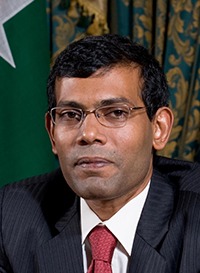
As Maumoon Abdul Gayoom's presidency came to an end, he sought re-election in the country's first democratic elections. He lost to Mohamed Nasheed, an activist and politician who has been criticizing Maumoon's government, won with 54% of the votes while Gayoom only had 45%. Nasheed famously held the world's first underwater cabinet meeting to push a stronger climate change agreement for the 2009 United Nations Climate Change Conference. His presidency was marked with political turmoil. On 29 June 2010, Nasheed's entire cabinet resigned and alleged that the opposition parliament members are power grabbing making it impossible for the ministers to execute their responsibility. In January 2012, Nasheed ordered the arrest of Judge Abdulla Mohamed against court orders. Nasheed's presidency faced a major political crisis which led to resignation his resignation. He later stated that former president Maumoon and vice president Mohamed Waheed Hassan Manik plotted the coup against him.
Waheed presidency
Mohamed Waheed Hassan Manik, Nasheed's vice president became the President after his resignation on 7 February 2012. The Commission of National Inquiry (CoNi) was established by President Waheed to investigate what happened on 7 February 2012. The CoNI report revealed that the transfer of power was legal and Nasheed's resignation was voluntary and there's no evidence to support Nasheed's version of events. The CoNI report was endorsed by the Commonwealth of Nations, U.S. Department of State, United Nations and the Foreign & Commonwealth Office.
Yameen presidency
As Waheed's presidency came to an end after the 2013 Maldivian presidential election results came out, Abdulla Yameen Abdul Gayoom was sworn in as the new President. Yameen obtained 53,099 votes while Waheed obtained 10,750. In 2015, former president Mohamed Nasheed was found guilty on terrorism charges and was sentenced to 13 years in prison which many calls politically motivated. He later fled to the UK in May 2016 and got asylum.
In July 2015, Yameen's first vice president, Mohamed Jameel Ahmed got removed by parliament through a no confidence motion against him and then-Tourism Minister Ahmed Adeeb Abdul Ghafoor was sworn in as the Vice President. In November 2015, Ahmed Adeeb was removed as Vice President following a no confidence motion against him by the parliament. He was charged with treason in connection with the explosion on President Yameen's speedboat. On 22 June 2016, Abdulla Jihad was appointed as the third Vice President.
In June 2016, in an investigation titled "Stealing Paradise" by Al Jazeera which uncovered corruption and islands being leased at discount prices without public tender. In 2018, Yameen unveiled Sinamalé Bridge, which connects Malé, Velana International Airport & Hulhumalé with the help of the Chinese government. The Maldives also left The Commonwealth after human rights abuse allegations were made.
Similarly to Nasheed's presidency, Yameen's presidency had also faced a political crisis, which led to Yameen declaring a state of emergency. During the state of emergency, Yameen ordered the arrest of Maumoon Abdul Gayoom (his half brother), Chief Justice Abdulla Saeed and Justice Ali Hameed. He had ordered the arrest of many of his political rivals such as Qasim Ibrahim.
Solih presidency

Abdulla Yameen's presidency came to an end after he was defeated in the 2018 Maldivian presidential election. Yameen received 96,052 votes while his successor, Ibrahim Mohamed Solih (Ibu), the MP for the Hinnavaru Constituency received 134,705. In 2020, the Maldives re-joined the Commonwealth.
Solih's government had increased the use of Renewable Energy Sources such as solar power to reduce the country's reliance on imported fossil fuels. New hospitals were constructed on the islands and some were upgraded. Maldivians were frustrated with his government due to Solih's failure to crackdown on corruption in the government and some accuse him of normalising corruption. Solih announced Thilamalé Bridge, a bridge that aims to connect Malé, Villingili, Gulhifalhu, and Thilafushi. There has been many concerns with the development of the bridge such as environmental concerns and quality assurance.
Muizzu presidency
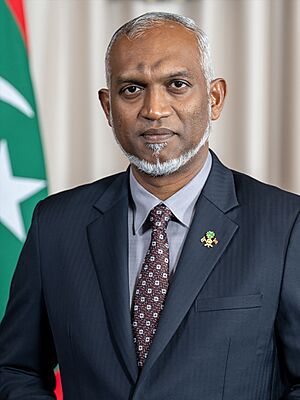
Ibrahim Mohamed Solih's term ended after he was defeated in the 2023 Maldivian presidential election. He received 86,161 voted in the first round and 109,868 votes in the second round. His successor, Mohamed Muizzu, a politician and engineer who has served senior government positions in the past, obtained 101,635 votes in the first round and 129,159 votes in the second. Mohamed Muizzu's government was faced early on in the beginning of 2024 with strained relations with India after three Deputy Ministers of the Ministry of Youth, Empowerment, Information and Arts tweeted against Indian Prime Minister Narendra Modi. It also led to Indians boycotting visiting the Maldives and the deputy ministers being suspended. Two deputy ministers resigned after an 8-month suspension with pay, and soon they were hired in MACL and HDC at high-salary positions. 3 ministers from Mohamed Muizzu's cabinet, Mohamed Shaheem Ali Saeed, Ali Haidar Ahmed and Ahmed Usham were rejected by the parliament, which led to Muizzu re-appointing the three ministers.
List of presidents
See also
 In Spanish: Anexo:Presidentes de las Maldivas para niños
In Spanish: Anexo:Presidentes de las Maldivas para niños
- List of Maldivian presidents by age
- President of the Maldives
- Politics of the Maldives
- History of the Maldives
- List of sultans of the Maldives
- List of head of state of the Maldives
- First family of the Maldives
- Prime Minister of the Maldives
- Vice President of the Maldives
- First Lady of the Maldives
- Second Lady of the Maldives




